
Water Rate Adjustment for Tulalip Utilities Customers

syəcəb


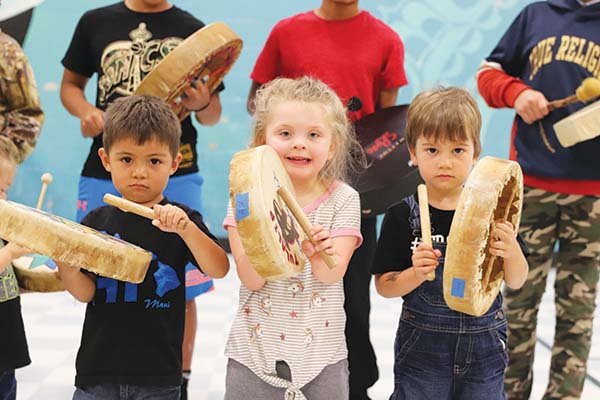
By Kalvin Valdillez, Tulalip News
Not so many generations ago, Tulalip youth were once punished for speaking their language and practicing their traditions at boarding schools that were established to erase Native culture by the United States government. Today, the young people of Tulalip are not only proudly drumming and dancing at school, but also passing that knowledge down to the next generation.
The morning of July 12 marked the tenth Cultural Day celebration of the year at the Betty J. Taylor Early Learning Academy (TELA). The academy introduced the monthly half-an-hour gathering to their students in October 2018, and since then the students have been engaging in a number of activities, learning about the lifeways of the Tulalip people.

Upon joining forces with the Lushootseed language department, TELA also successfully implemented a language immersion component into their curriculum. Lushootseed teachers frequently visit the classrooms to share stories, sing songs and speak the language directly to the students.
“I believe that our children need to know from the youngest ages who they are,” says Betty J. Taylor Early Learning Academy Director, Sheryl Fryberg. “Research says, if they are totally connected to who they are as birth to five children, they’re going to be more successful in their lifetime because they have that solid sense of self.”
Over the years the Tulalip Tribes has made strong efforts incorporating cultural teachings at each academic level, partnering with the Marysville School District to ensure Tribal students know about their art, food, history, language, sovereignty and traditions. So as the kids make their way through their educational journey, they will continue building upon the vision their ancestors set forth seven generations prior. And the work TELA is doing is helping strengthen that bond between each student and their culture, providing a strong foundation for the future leaders.
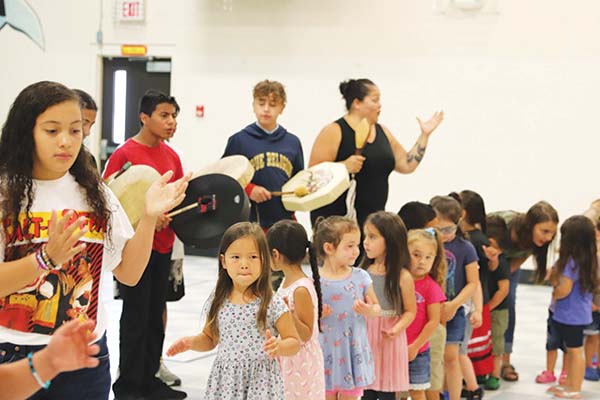
Quil Ceda Tulalip Elementary (QCT) is one of the schools teaching their students about Tulalip’s rich history and heritage. Under Cultural Specialist Chelsea Craig, the school has established a morning assembly where the students begin each school day singing and dancing to Tulalip songs, such as the welcome song and the paddle song. QCT also hosts a number of cultural events throughout the year including Billy Frank Jr. week and the 5th grade potlatch.
Through the development of QCT’s morning assembly, Chelsea cultivated a strong group of young singers and dancers who proudly honor their ancestors by performing at every assembly. Those students, some of whom are now in middle school, continue drumming and dancing at local cultural gatherings and coastal jams, sharing their teachings with their pupils.
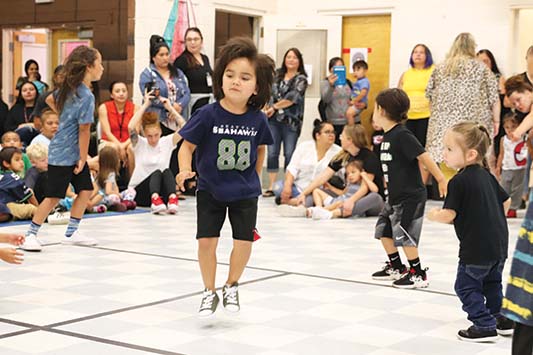
Combining efforts to ensure the youth have a strong connection to their cultural way of life, TELA invited Chelsea and company to lead a culture jam for one of the last Cultural Days of the school year.
The young TELA students were invited to participate in the jam and enthusiastically followed the lead of the older kids, some picking up a drum and singing while others took to the open dancefloor. For thirty exciting minutes, the kids enjoyed themselves to no end, getting lost in song and dance.
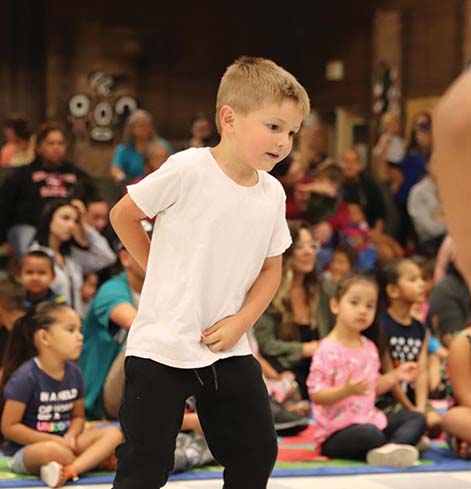
During this interaction, the students learned some important and valuable lessons from their older peers such as to only drum when offering a song, and also how each dance correlates to the message of the songs. By hearing the songs early in life, the kids are more likely to remember the words, the drum patterns and dances, so when the time comes for them to share their knowledge, they too can lead with confidence, respect, gratitude and purpose just like Chelsea’s young group of traditional singers and dancers.
“It’s such a blessing to be invited today because these students are our future drummers and singers,” Chelsea expresses. “To start making those connections with their next transition in school is something that we’re purposefully doing to start instilling these songs at a very young age. And to see their peers as leaders, that’s important. Our drummers are our leaders and they’re someone to look up to and inspire to be. It warms my heart because some of the little ones here may have never danced before this morning, but they feel it in their heart and feel safe enough in this school to get up and express it a very young age.”
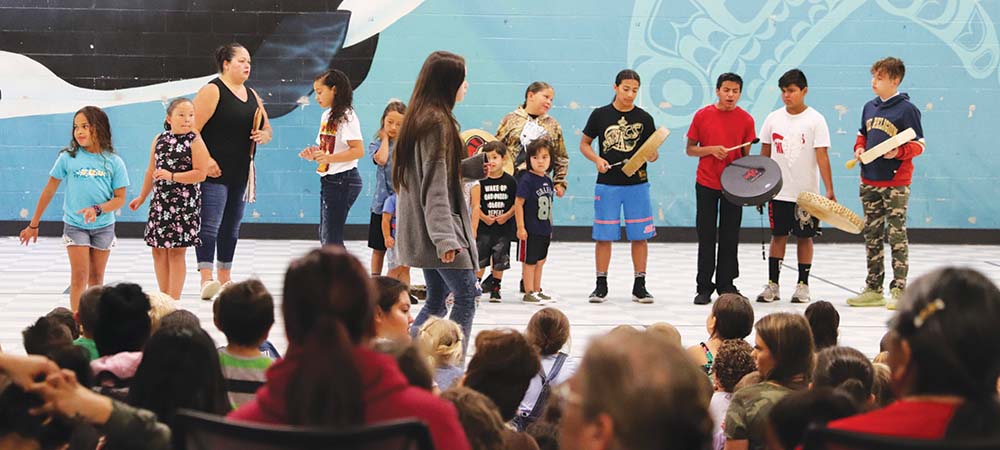
Kids soak up knowledge at a young age and with TELA’s monthly Cultural Days and the Lushootseed language immersion-based curriculum, the newest Tribal members will have a lifelong connection to their heritage and a deeper understanding of their ancestral teachings.
“They all loved it,” Sheryl stated. “I’m just so grateful that our teachers, our children and our visitors are so in love with the culture and the language; we just keep doing the work and it keeps growing.”
The Betty J. Taylor Early Learning Academy will officially wrap up the school year with the Paddling to Preschool event on August 13, as well as an end of the year celebration on August 16. For more information, please contact TELA at (360) 716-4250.
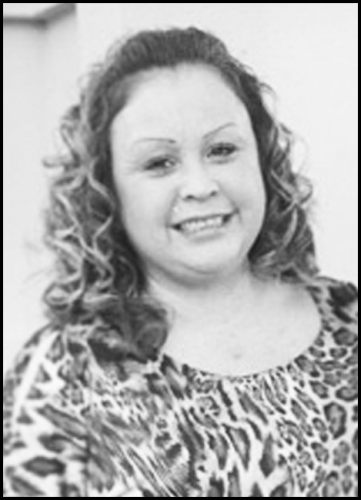
Sunrise: February 2, 1969 Sunset: July 15, 2019 Crystal Lynn (Gobin) Wassillie was born on February 2, 1969 to parents, Rhonda Faye Gobin and James Morris, Sr. and made her journey to the ancestors on July 15, 2019. She was raised with the greatest teachings by the strong women in her family; an unbreakable bond with her mother who taught her to be a giver to the community, sharing unconditional love to all. Crystal was a proud Tulalip Tribal member and spent most of her life on the Tulalip Reservation where she raised her four children: Dustin, Taylor, Marlee and Carter. Crystal lived life to the fullest and especially enjoyed spending her time garage saleing, dancing at Travelers 1, 2 and 3, any and all cultural events, camping with her children in Chelan, WA, being surrounded by family and friends, most especially her grandchildren, and she loved casino hopping. She was proud to serve her community by any means, working in numerous positions for the Tulalip Tribes including various positions at the Tulalip Casino, Caregiving, and the ARMS program with Family Services. She leaves strength and love behind in her children: Dustin (Cody), Taylor, Marlee, Carter, Shelby, Hayden and Tatiana; her mother, Rhonda Faye from Tulalip Bay; grandkids, Aaliyah Hatch, Diego Moses, Gracelynn Hatch and Nizhoni Phair; aunties, Valda (Herb), Helen (Dave), Debbie (Dean); uncles, Billy (Teri), Jonny (Candy), Tony (Judy), Mike (Rae Anne); brothers, Jim (Christina), Joe (Deanna), Lindy (Dora), Steve (Danielle), Brodie, Junior and Joey Lugo; sisters, Alicia Lugo, Paula Hatch and Martina Myers; and special friends, Karen Zuehl, Sara Lacy and Raylynn Davis. She was welcomed on the other side by the love of her life, David James; also greeting her, grandmothers, Ebey, Nonie and Donie; fathers, James Morris, Sr., Jerry Torres and Gerald Lugo, Sr.; aunties, Marilyn Lewis, Wendy Young, Marilyn and Merri Morris; cousins, Teddi Shane, Gordy Hawk II and Spencer Morris; and her fur babies, Sissy and Macho. Crystal will be missed by many family and friends and remembered for the love and light she shared on her walk. Visitation will be held Thursday, July 18, 2019 from 1:00 – 2:00 p.m. with an Interfaith Service to follow at 6:00 p.m. at the Tulalip Gym. Funeral Services will be held Friday at 10:00 a.m. at the Tulalip Gym with burial to follow at Mission Beach Cemetery.
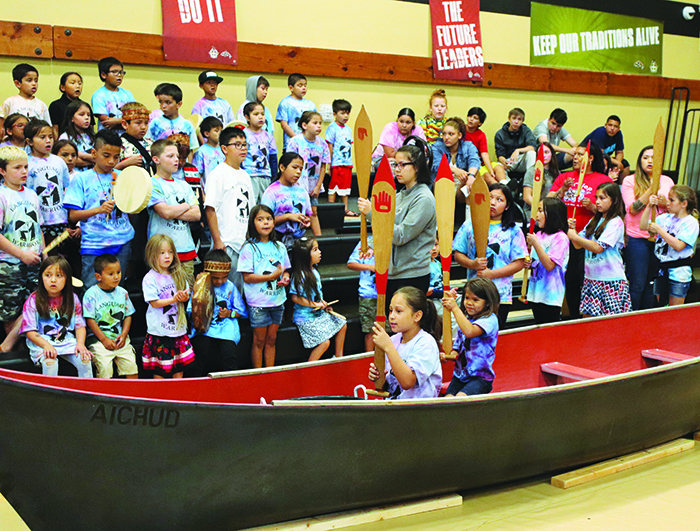
By Micheal Rios, Tulalip News
School is out for summer, but traditional teachings never stop in Tulalip. For the twenty-fourth consecutive year the committed Lushootseed staff, affectionately referred to as Language Warriors, organized a week full of fun, learning and interactive cultural lessons for community youth.
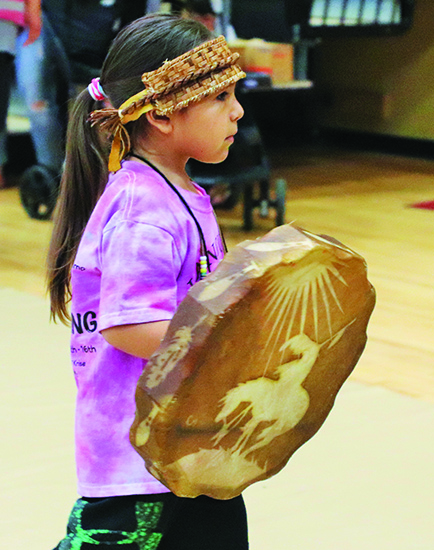
During the 5-day stretch of July 8-12, the Pacific Northwest was pleasantly warm with the occasional overcast. Inside Don Hatch Youth Center the real radiating beams of sunshine could be found, created by 60 inspiring kids participating in week one of the 24th Annual Lushootseed Day Camp.
Open to children age five to twelve with a desire to learn about their traditional lifeways and language of their ancestors, Lushootseed Camp provides invaluable cultural teachings through art, songs, technology, weaving and storytelling. Each year the Lushootseed Department teams up with a select number of vital community volunteers and culture bearers to hold two, one-week day camps in the summer.
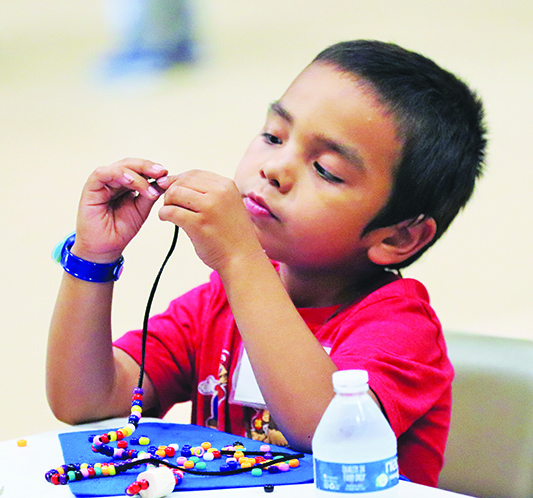
“Our department gathered clams, harvested Devils Club and cedar bark just before camp started to help us all in experiencing the valuable lessons we wanted to pass on to the youth in various activities,” explained Lushootseed Teacher Natosha Gobin. “Originally we wanted to get the youth out in the lands where their ancestors gathered, but were unable to because of transportation costs as well as tides, but we did arrange for them to harvest marsh tea with the assistance of our Natural Resources colleagues.”
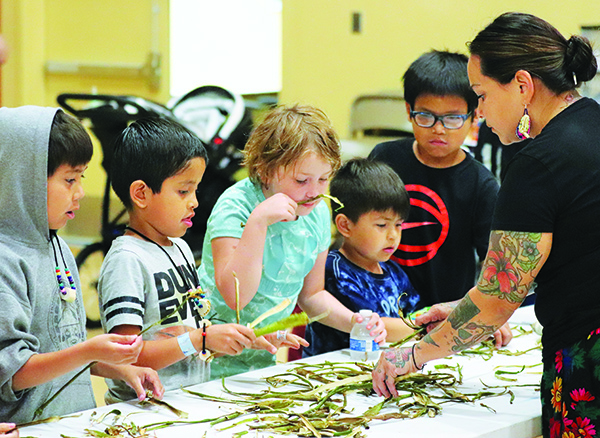
With the impressive turnout in camp participation came an equally impressive turnout in teenaged helpers to assist Lushootseed staff coordinate daily camp activities. There were 10+ summer youth workers, most who had been day camp participants themselves as kids, filling the role of group leaders.
Throughout the weeklong camp, youth participated in a variety of daily stations or activities. The following list is what each child accomplished on a near daily basis:
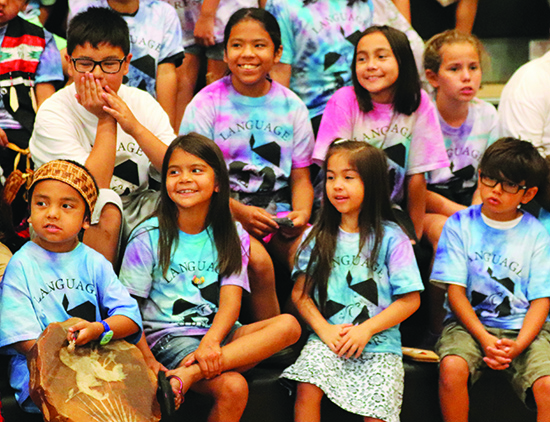
Every station and daily lesson incorporated traditional teachings and Lushootseed verbiage. Using creative hands-on activities to keep the energetic youth focused, the Language Warriors made the most of their opportunities to teach the youngsters about tradition. From vibrant art creations to the proper cleaning and care of clam shells to working together as a community to problem solve, camp kids were learning while having fun.
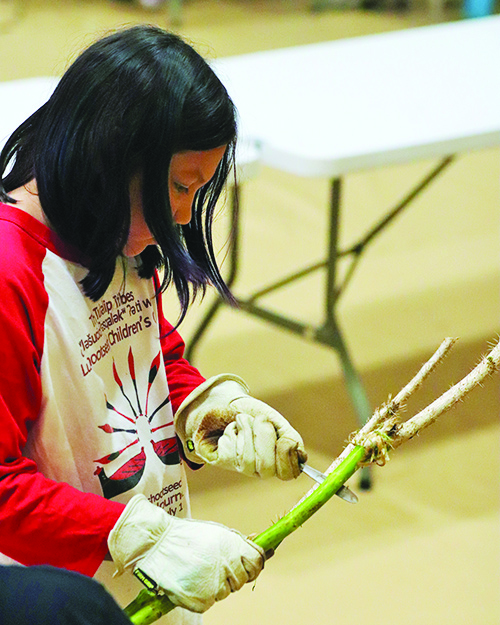
Using tablets loaded with custom built software and the kids’ natural inclination for digital screens, Lushootseed techy Dave Sienko used videos and cartoons to teach tradition.
“To focus on what is being taught specially at this year’s camp we utilized the ACORN (Acquisition Of Restored Native Speech) Language App developed by Southern Oregon University,” said Sienko. “This app allows us to gather the materials the teachers want taught and update it on the fly. I also added several videos that fit with the focus of this year’s camp.
“It’s always amazing to witness how excited some of the students get when they are watching videos to learn about their ancestors, their relationship with nature, and animated traditional stories.”
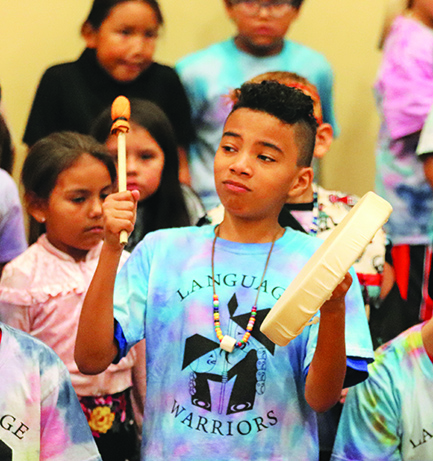
A point of emphasis this year was to teach how Devil’s Club was traditionally used for a wide range of purposes. Several of the activity stations featured Devil’s Club as a fixture for arts and crafts, like necklace or bracelet adornments, or showcased its medicinal purposes.
“Devils Club is a traditional medicine that is culturally, spiritually and physically healing,” shared Natosha as the kids lined up with peaked interest to help harvest the cool named plant. “It’s healing includes aiding in relief of sprains, arthritis, boils, muscle and joint pain, as well as cleansing. Learning how to identify, harvest, process and create medicines with this sacred plant was a recent opportunity enjoyed by us teachers and we’re excited to pass on what we learned.”
The youth witnessed first-hand the transformation of Devil’s Club from its natural form by carefully assisting their teachers to shave off the Devil’s Club bark and process it into a healing salve. Many of the kids couldn’t help themselves and took in big whiffs of the freshly cut plant and its unique fragrance.
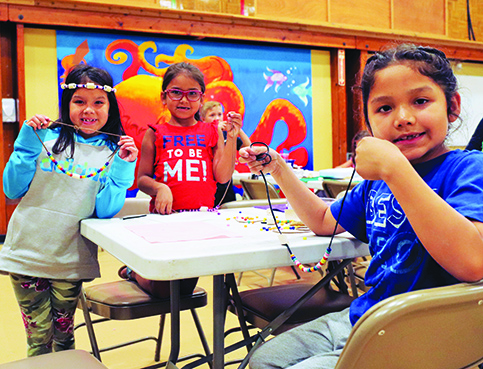
“It smells like a tasty salad!” shouted super excited Rajalion Holland after treating her nose to a few smells of Devil’s Club bark. “Are we really going to use this to make medicine for owies and boo-boos?”
“Yes, we already turned it into medicine…a lot of it,” answered 9-year-old camper Rilla Jones. “We mixed Devil’s Club with melted bees wax and coconut oil, and poured it into tins so the liquid can dry. It becomes a medicine called a salve that heals your skin if you’re hurt.”
For this 24th Annual Lushootseed Camp, Elizabeth “Lizzie” Krise was honored for her leadership and teachings she passed on to the Tulalip community. She’s remembered as one of the key people who helped preserve the Snohomish language. The work she did in the 1960s helped lay a foundation for the current generation of Lushootseed educators to learn, speak and teach their ancestral language. Her story “Lizzie’s Clam Digging” was chosen as the main lesson all teaching stations were built around in a week filled with learning and living a proud Coast Salish culture.

That culture was on full display during the closing ceremony for week one’s camp. Taking place at noon on Friday, July 12, the eager and understandably nervous young play-performers made their stage debut to a community audience of supportive family and friends. Different from previous years, instead of individual kids alternating lines and narration, this particular group performed as one unified voice. They stood up tall and narrated in unison the ten line Lushootseed story, “Lizzie’s Clam Digging.”
Before and after their story rendition, the kids sang and drummed while performing several traditional songs unique to their Tulalip culture. Their sixty minutes of stage time allowed for plenty of reflection and, of course, photo opportunities. “Looking at all these young children here today, I’m very proud each of them for learning our language and keeping it alive,” said Herman Williams Sr. after witnessing the camp’s closing ceremony. “It’s our responsibility to encourage our young ones to build a new walk of life while knowing who they are and remembering where they come from.”
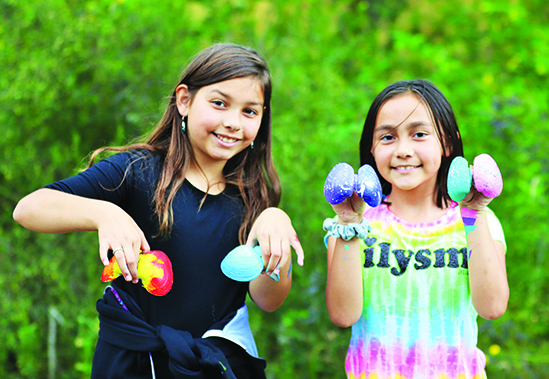
“It was a great honor to witness you all stand up with pride and sing those songs. You all did an amazing job. I got a chill in my body because I felt our ancestors smile,” added ceremonial witness CaryMichael Williams, great-great-grandson of Lizzie Krise.
After the youth’s inspiring performance there was a large giveaway with hundreds of unique items handmade by the campers, including Devil’s Club beaded necklaces and tins of healing salve. Audience members left and right were taken aback by the gifts as they kept coming one after another from their enthusiastic creators. Closing the event was a buffet-style lunch featuring freshly baked Sockeye and an endless bounty of clams.

Reflecting back on their week of Lushootseed Camp, two future leaders summed up their experiences and all they learned perfectly. “I liked all the activities and how they each taught us something about our culture,” said 10-year-old Sophia Quimby. “Every single station we’d go to would teach us a Lushootseed word. Having our teachers from school here made it easier to learn.”
“The songs and dances were a lot of fun, too, because I enjoy doing those things,” added 11-year-old Katherine Velasquez. “I enjoyed all the traditional teachings that we got. My favorite parts of the week were doing tie-dye art and learning about Devil’s Club.”
Learning about clam digging, harvesting from nature, creating medicines from traditional plants, creating vibrant cultural items, and learning Lushootseed words that can be used daily were primary goals of this year’s camp. From the sentiments expressed by the youth participants, it’s safe to say those goals were achieved.
As we approach the halfway mark of summer 2019, now is a good time to revisit a lesson that many of our parents and grandparents recited to us on a regular basis during this time of year: go out, get some fresh air and enjoy the sunshine.
With the Fourth of July excitement well behind us, we may be quick to find excuses to stay inside and relax in the cool A/C comfort of our homes. And of course there’s nothing wrong with that, it’s important for our bodies to decompress and recharge, but in the same breath, it is also equally important to make sure the body is getting the exercise it needs and deserves after staring at technology screens for days on end.
From the high mountain ranges to the cool coastlines of the Salish Sea, the Pacific Northwest is a nature wonderland, filled with breathtaking views and landscapes. The summer season is the perfect time to take a social media break and experience the great outdoors, to disconnect from the world and reconnect with Mother Earth, if you will.
Tulalip community member and SNAP-Ed Nutritionist, AnneCherise Jensen, set aside some time to share a few ideas on how local citizens can take advantage of the long summer days, get outdoors and have a little fun in the sun.
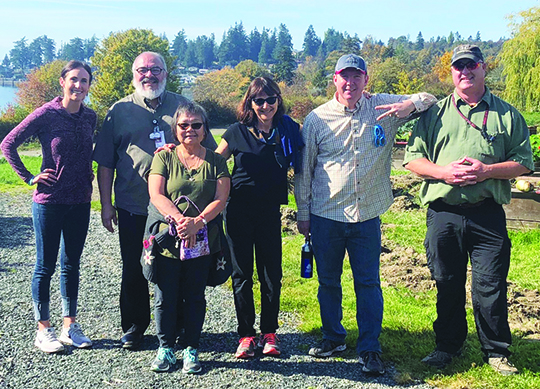
Okay, first things first. Why is exercise important for our bodies?
Exercise is the best form of preventive medicine. Our bodies are like a machine, if you don’t use it, you lose it. We need to be moving our bodies and pushing them to their fullest potential in order to keep our bodies healthy. The reason why exercise is important is because it helps take care of our organs – our heart, our lungs, our kidneys. Physical activity is medicine for the body, it helps repair itself. The more sedentary we get, the weaker our organs get. The more exercise we get, the more we’re strengthening our body, and the more resilient we’re making it to outward things that are coming inside. It helps relieve a lot of the toxins that we’re exposed to in today’s environment. The biggest reason exercise is so important is because it reduces the risk of diabetes, certain types of cancers, obesity and heart disease.
It’s summertime! The warm weather presents a great opportunity for outdoor recreation, what are some fun activity ideas the community can do before the summer ends?
One thing that I love to do is go on small little hikes throughout the summer. We live in a really nice area where we have local access to trails. There’s lots of really good ones out in Mountain Loop Highway like Coal Lake, Lake 22, Heather Lake, Mt. Pilchuck. Those are really good trails, moderate to beginner ones.
Riding bikes is awesome if you have access to fun and safe roads, same with going to the skate park. Also, going to the beach for a swim. Swimming is a really great way to exercise, burn calories, keep your cardio up and it’s real forgiving on your joints. That’s a pretty good start. If you’re feeling like you’re not very flexible or have a lot of pain, I recommend yoga or chair yoga.

For those who are interested in hiking but have never been, what type of gear is needed before retreating to the mountains?
A good pair of hiking shoes. You’re going to want something that is water resistant and has a good sole. I recommend Salomon/Arc’Teryx at the outlet mall, they have really good prices on shoes. Also Columbia, and REI is a really good place to go if you’re in the Lynnwood area. Always make sure you have your ten essentials and those include matches, water, a compass, map, food, an emergency blanket (see image for complete list). You always want to make sure you have a rain jacket when you’re up in the mountains. You never know what the weather is going to be, so you want to make sure you have a waterproof jacket that provides warmth. Always know where you’re going, read a trip report. A good source to get information like that is the Washington Trails Association at www.WTA.org
Hiking and camping often go hand-in-hand and camping is a great summertime group activity, any advice for first time campers?
There are two ways to camp; you can park and have all your gear out and camp close to your car, or you can go overnight backpacking where you pack all your overnight gear. That’s a really great experience, probably my number one favorite thing to do in the summertime is to go camping in the mountains. You want to have dehydrated food, lots of water and a water purifier so you have a clean water source. The experience is a good way to disconnect and get in tune with yourself, especially if you’re a spiritual person.
You always want to make sure you know where you’re camping and do a little research beforehand. Make sure that you set up in a designated camping spot and that you have enough food to secure you at least one day extra than you planned.
Canoe Journey is happening now and is extremely popular amongst tribal nations, what are a few tips for the canoe pullers?
When you’re out on the water, make sure you bring lots of water that have electrolytes, because a lot of time you’re in the blazing sun and sweating a lot and in order to retain the water you drink, you want to have enough sodium, potassium, magnesium, so that way you don’t get fatigued.
More important than anything, wherever you’re going, the mountains or the water, make sure you’re with a group of safe people, people you can trust and rely on. And also, follow the LNT principals, Leave No Trace, respect the outdoors and make sure you leave it better than you found it.
What are some fun ideas for folks who want to enjoy the sun in the comfort of our community?
One of my favorite things to do in the area, if you can get a fun group together, is to go on a trash cleanup. Even if you just work in your local area, community, block, or beach, grab some gloves and a couple other people and fill your bags up with trash. It’s super rewarding and fun.
If you have a dog, or even a cat, definitely walking and playing with your pet. I just got a dog this year, his name is Copper, we take him hiking in the mountains or we’ll take him to the beach. We have lots of local beach access points out here. Strawberry Fields, out in Arlington, is also a really great place to take your dog. It has a nice mile-and-a-half long trail so you’re getting some exercise yourself along with the dog.
Last but not least, I highly recommend going to the YMCA, especially if you have kids and a free membership. You can play basketball with your kids or take them swimming.
This time of year, many people can be found tending to their personal gardens and cultivating nutritious crops. Can you talk about the benefits, both physical and nutritional, there are when growing a garden?
Gardening is a great activity, even if you just have one bed. Being out with the plants helps you develop a really good relationship with the plants and food. You’re able to get some vitamin D from the sunshine and also mild physical activity, it gets you moving. Kale, potatoes and carrots are all really easy to grow and you can add those to any meal and do oven-baked vegetables.
You can also go harvesting for native plants. Harvesting is another wonderful thing to do this time of year, especially out here on the reservation. You can go out and find an area to harvest berries and you can use those to bring home and make salads or other interesting things. Everything is in season right now. I’ve noticed there’s a lot of fruit trees out here, so if you have access to a fruit tree you can gather enough to make pies, jams, desserts and fruit salads.
As you know, it’s BBQ season. Do you have any tasty recipes that people can chef up for their next cookout?
I have two recipes for BBQs! I have a strawberry mango salsa that’s yummy, you can add jalapenos, strawberries, mangos, tomatoes. You get a lot of servings of fruits and vegetables and it’s high in vitamin C too. Vitamin C is great to eat a lot of throughout the summertime, especially before the cold weather hits. You can do pico de gallo if you don’t like it with the fruit.
And fruit kabobs. We’re going to have fruit kabobs at the Tulalip Health Clinic’s annual Health Fair on July 26th. It’s a good way for kids to try new fruits that they haven’t been exposed to. Try to have ten different fruits available and you can put it on a kabob and take it with you.
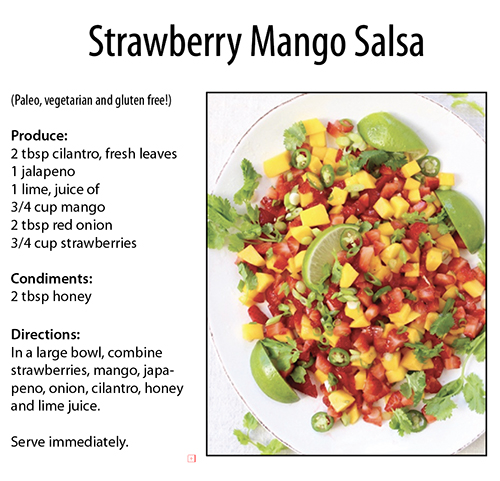
Are there any upcoming events you would like to share with our readers?
If you’re looking for more things to do at Tulalip, we have our Garden Days. Our next one is going to be August 3rd at 10:00 a.m. We always start each Garden Day with a mile-and-a-half walk. And we also have our walking club every Wednesday at noon at the Health Clinic, it’s always fun to get out there and go for a walk by the bay.
For further details, please contact SNAP-Ed at (360) 716-5632.
Please use the following link to download the July 20, 2019 issue of the syəcəb:

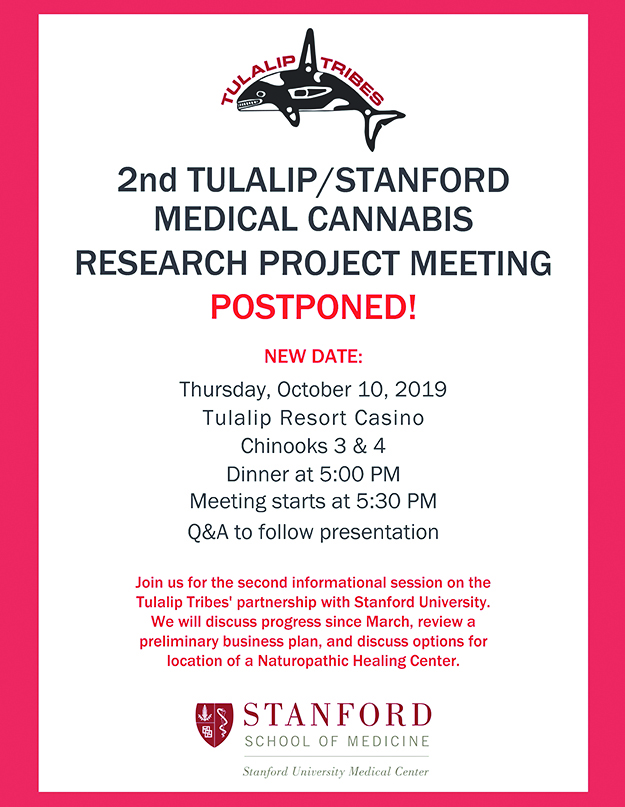
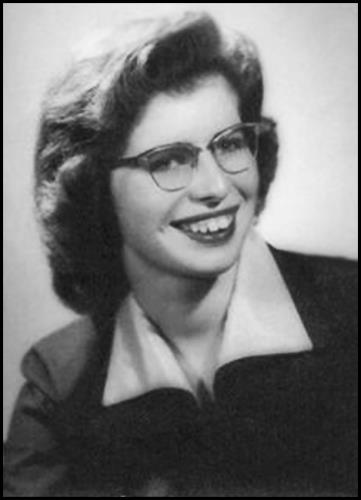
Carol was born Carol Jean Shiplet in Monroe, WA, at her grand-parents’ home. She died two days shy of her 81st birthday.
Carol was born on her mother’s birthday. Her parents were Dorothy Ellen (Aldridge) Shiplet and Emory Luther (Million) Shiplet. She started off her first few years in Skykomish, WA, and then down in the Ravenna/Greenlake area where her father was a fireman. She went to Lincoln High School. She met and married Larry Leroy Cepa. Carol was a spouse of a Tulalip Tribal member. They were married for 57 years. They started married life in Lake City, Ballard, then Edmonds, WA. They had three children: Laurie, Dennis and Lisa. Carol loved camping and fishing with the Galer’s and Bjerkness’s. She had an in-home day care for 16 years. She retired as a reconcilement clerk in the banking industry. She was also the bookkeeper for a diaper service she and Larry owned and were partners in for several years in Ballard. She loved sewing and was very talented, especially doll clothes. Carol would dress dolls that were refurbished, giving to children at Christmas time. She made beautiful teddy bears. She made Raggedy Ann and Andy dolls for children at Fred Hutchinson hospital. She used to hold and rock babies at Children’s Hospital. She made donations to charities that corrected children’s cleft palates. She had a special relationship for these charities as she had a jaw that was damaged in childhood. She was one of the first patients in Seattle to get tooth implants. Carol loved dogs and cats, her eyes would light up when she would see them walk across the room or jump up in her lap. She also really enjoyed playing pinochle with friends and her mother until she could no longer drive to the card parties. Her last projects were sewing pillows and gowns for Hospice and tying lap quilts with her mother and doing jigsaw puzzles.
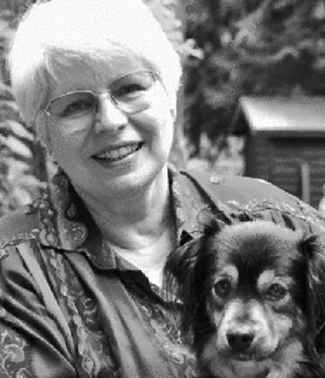
Carol leaves behind her children, Laurie Cepa, Dennis Cepa and Lisa Cepa; her sister, Peggy Trim (Larry) and brother-in-law, Danny Stamaris. She leaves behind her nieces and nephews, Larry Trim (Lois), Mark Trim (Janet), Louis Trim (Kelley), Lois Brown (Tom), MaryJo Trim, Terry Parker (Pam), Sherry Guzman (Pete), Ennette Brumbaugh, Ron Burns (Donna), Brad Burns (Josie), Jim Barrie (Evelyn), Craig Barrie (Rochelle), Sunny Golden (Doug), Daniel Stamaris (Heather), Don Stamaris (Michelle),Rose Ward (Karl Miller), Dean Fewkes, Tom Aldrich, Scott Aldrich, Stacy Wallace, Martin Cepa, Adam Cepa, and Carolyn Cepa. She is predeceased by her husband, Larry L. Cepa and parents, Emory and Dorothy Shiplet. Alzheimer’s stole a beautiful person from us too soon. Her smile and laughter will be missed.
The funeral service will be held Wednesday, July 17, 2019 at 10 am at Schaefer-Shipman Funeral Home located at 804 State Avenue, Marysville. Burial will follow at Mission Beach Cemetery. In lieu of flowers, donations may be made to your favorite Alzheimer’s research charity.
